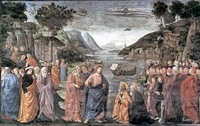
Fresco (1481-2) of Christ calling SS Peter and Andrew
Sistine Chapel, Rome
attributed to Domenico Ghirlandaio
The Florentine Domenico di Tommaso di Currado di Doffo Bigordi acquired the surname “Ghirlandaio” from his father, a goldsmith who was famed for creating the garland-like necklaces. Domenico seems to have trained first as a goldsmith before moving on to painting. He entered the painters’ guild in Florence in 1472. He subsequently established one of the most prosperous workshops in Florence, which he ran in collaboration with his two younger brothers, Benedetto (1458-97) and Davide (1452-1525).
He worked on the now-lost frescoes of the Biblioteca Vaticana, Rome in 1475, assisted by his brother Davide and (probably) by Antoniazzo Romano. In 1481, Giovanni di Dolci, on behalf of Pope Sixtus IV, signed a contract with Ghirlandaio, Sandro Botticelli, Cosimo Rosselli and Perugino to paint ten bays of the Sistine Chapel. Payment was agreed with the same four artists in 1482 for the decoration of four bays (presumably one each) that had been completed. The fresco illustrated above, which depicts Christ calling SS Peter and Andrew, is thought to be the fresco painted by Ghirlandaio.
Ghirlandaio’s other surviving works are mostly in Florence. The two most important of these were fresco cycles, each of which was commissioned for partner in the Medici bank:
-
✴the fresco cycle (1480-5) in the Sassetti Chapel of Santa Trinità, which depicts scenes from the life of the St Francis, commissioned by Francesco Sassetti; and
-
✴the fresco cycle (1486-90) in the choir of Santa Maria Novella, which depicts scenes from the lives of the Virgin and St John the Baptist, commissioned by Giovanni Tornabuoni.
The young Michelangelo seems to have trained with Ghirladaio in Florence in ca. 1488.
Ghirlandaio died prematurely during an epidemic of plague in Florence.
Città di Castello
Coronation of the Virgin (15th century)
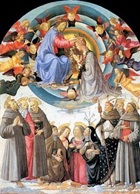
Narni
Coronation of the Virgin (1486)
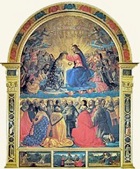
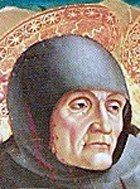
The altarpiece was painted in the Ghirlandaio workshop in Florence. It was on the high altar of San Girolamo until 1781, when it was moved to the wall of the apse. It was taken to Palazzo Comunale in 1871 and is now in the Pinacoteca.
In the upper register of the main panel, Christ crowns the Virgin, surrounded by angels, many of whom play musical instruments, together with patriarchs and prophets. 22 saints in the lower register meditate on the scene The saints include:
-
✴St Francis, who kneels in prayer (at the centre) with the stigmata clearly visible in his hands and side;
-
✴St Jerome (the titular of the church), who wears a red cardinal's cope and looks out at the viewer (centre right);
-
✴St Antony of Padua, who kneels barefoot to the right of St Jerome;
-
✴St Bonaventure, who had been canonised in 1482 (centre left). Like St Louis of Toulouse to his left, he wears a sumptuous cope (indicating ecclesiastical office) over his Franciscan habit; and
-
✴St Bernardino of Siena, behind and immediately to the left of St Francis.

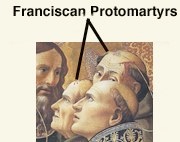
The figure behind St Bonaventure, who wears a black hood and has a head wound, is almost certainly St Berardo (the name saint of Cardinal Eroli, also illustrated above), one of the five Franciscan protomartyrs, who had been canonised in 1481. The other four protomartyrs, who also sport head wounds, are included in the composition (two on the extreme right and two to the left of St Berardo).
Three standing saints are depicted on each side of the frame. The predella depicts:
-
✴the stigmatisation of St Francis;
-
✴the Pietà; and
-
✴St Jerome in the dessert.
Other Works based on Narni Altarpiece
Monteripido Altarpiece (1502)
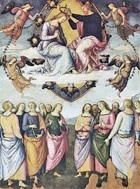
The altarpiece is now in the Galleria Nazionale.
Coronation of the Virgin (1502-5)
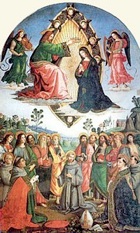
Raphael might well have assisted in the design of the main panel during a stay with Pintoricchio in Siena:
-
✴a preparatory drawing for two of the kneeling figures in the foreground, which is now in the Musée du Louvre, Paris, is attributed to Raphael;
-
✴the positioning of the figures in the lower part of the composition in a semi-circle around St Francis, against a landscape, is related to the composition of Raphael’s Oddi Altarpiece (see below); and
-
✴the 2nd Apostle on the left in Pintoricchio’s altarpiece is taken from the figure of St Thomas in Raphael’s.
The payment to Giovanni Battista Caporali suggests his involvement, at least in the later stages.
Pintoricchio’s altarpiece was sent to France (with an attribution to a follower of Perugino) in 1812. Its predella was subsequently lost, but the main panel was returned to Rome, where Pope Pius VII bought it from the friars. This panel, which is now in the Pinacoteca Vaticana, depicts:
-
✴the Coronation of the Virgin in front of a mandorla, flanked by a pair of musical angels; and
-
✴below, the Apostles and, in front of them, five kneeling Franciscan saints: SS Bernardino of Siena; Bonaventure; Francis; Louis of Toulouse; and Antony of Padua.
Oddi Altarpiece (ca. 1503)
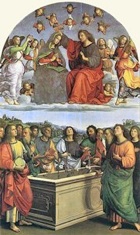
The main panel links two scenes from the narrative of the death of the Virgin:
-
✴In the lower part of the composition, the Apostles surround the empty tomb. St Thomas stands behind it, flanked by SS Peter and Paul and holding the Virgin's girdle.
-
✴Above, Jesus crowns the Virgin on a bank of cloud, surrounded by musical angels. The upper part of the composition was probably inspired by Ghirlandaio’s Narni altarpiece: as noted below, Raphael seems to have assisted at this time with the design of Pintoricchio’s Coronation of the Virgin (1502-5) for the Observant Franciscans of Santa Maria della Pietà, la Fratta (now Umbertide): this work was explicitly required to reflect Ghirlandaio’s work.



The predella panels, which are displayed separately in the Pinacoteca Vaticana, depict:
-
✴the Annunciation;
-
✴the Adoration of the Magi; and
-
✴the Presentation at the Temple.
Coronation of the Virgin (1507-11)
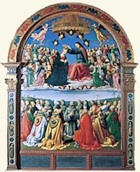
The contract specified that the composition should be based on that of the San Girolamo altarpiece. However, lo Spagna followed Pintoricchio and Raphael (above) by abandoning the gold backgraound and setting the lower part of the composition agains a landscape.
The altarpiece was requisitioned by the French in 1812, dismembered and taken to Paris. The main panel and its frame were subsequently returned to Todi and are now in the Pinacoteca there.
The three predella panels, which are now in the Louvre, Paris, depict:
-
✴the stigmatisation of St Francis;
-
✴the Pietà; and
-
✴St Jerome in the dessert.
Coronation of the Virgin (1522)
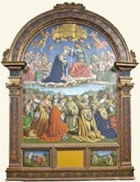
The main panel of the Trevi altarpiece is clearly based on that of lo Spagna's altarpiece at Santa Maria di Montesanto, Todi (see above), albeit that the lower part of it has been inverted.
-
✴In the upper part, Christ crowns the Virgin to the accompaniment of musical angels.
-
✴The lower part is set in a landscape of the Valle Umbra, with San Francesco, Assisi clearly visible to the right. Here, a group of kneeling saints meditate on the coronation:
-
•St Francis, kneeling at the centre;
-
•SS Martin (the titular of the church) and Bernardino of Siena immediately behind him (to the left and right respectively);
-
•SS Mary Magdalene, Bonaventure, John the Baptist and Jerome on the left;
-
• SS Augustine, Antony of Padua, Louis of Toulouse and Catherine of Alexandria on the right; and
-
•a number of Franciscan saints behind.
The predella panels in the Pinacoteca depict:
-
✴St Martin and the beggar; and
-
✴the stigmatisation of St Francis.
Coronation of the Virgin (1505-25)
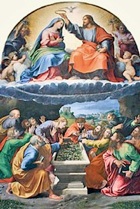
In fact, this contract was never honoured. A new contract drawn up in 1516 specified that the altarpiece should follow a design that had been submitted by Raphael. This design no longer survives, so it is unclear how closely it followed the Narni altarpiece. In any case, the altarpiece derived from it had not been started when Raphael died in 1520.
In 1523, the nuns agreed a new contract for the main panel of the altarpiece with two of Raphael’s associates in Rome, Giulio Romano and Giovanni Francesco Penni. The panel that was finally delivered in 1525 was in fact made up of two parts, painted on different occasions and then joined together:
-
✴the upper panel, which depicts the Coronation of the Virgin, is attributed to Giulio Romano; and
-
✴the lower part, which depicts the Apostles gathered around a tomb covered in flowers is attributed to Giovanni Francesco Penni.
The lower part of the composition is clearly not based on that of the Narni altarpiece. It is closer to the lower part of Raphael’s Oddi Altarpiece (above).
The panel, which was confiscated by the French under the Treaty of Tolentino (1797), was the subject of an important restoration in Paris in 1801. Antonio Canova recovered it in 1815, when it was secured for the Pinacoteca Vaticana.
Coronation of the Virgin (1541)
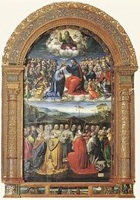
-
✴The landscape in the lower part of the main panel depicts the Convento dell’Annunzata, with the plain in front of it transformed into a lake.
-
✴The predella depicts:
-
•the Annunciation (at the extremes), in reference to the dedication of the church;
-
•St Jerome in the dessert;
-
•the Pietà; and
-
•the stigmatisation of St Francis.
The altarpiece, was removed from the church and dismembered so that the main panel could be exhibited in Perugia in 1907. The components were subsequently housed in San Benedetto and then, from 1967, in the Museo della Castellina. The components were taken to Spoleto for restoration after an earthquake in 1979, and remained there for some 25 years. The restoration was finally completed in 1994, and the reassembled altarpiece was returned to the museum.







